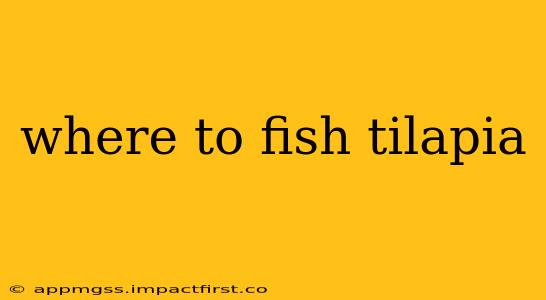Tilapia, a delicious and widely consumed fish, is a popular target for anglers worldwide. However, knowing where to find them requires understanding their habitat preferences. This guide will explore various locations where you can successfully fish for tilapia, addressing common questions along the way.
What bodies of water are tilapia found in?
Tilapia are incredibly adaptable and thrive in a variety of freshwater environments. You'll find them in lakes, ponds, reservoirs, canals, and rivers, particularly those with warm, slow-moving waters. They prefer areas with abundant vegetation, submerged structures, and shallow, sunlit areas where they can easily find food and shelter. Look for areas with plenty of aquatic plants like reeds, water lilies, and hydrilla.
What are the best places to catch tilapia?
The "best" place is highly dependent on your location. However, some general guidelines apply:
- Warm-water lakes and ponds: These are prime locations. Look for areas with structure such as docks, fallen trees, or rocky shorelines.
- Reservoirs: Many reservoirs support healthy tilapia populations, particularly in shallower, warmer bays.
- Canals and irrigation ditches: These often provide ideal habitat, especially in warmer climates.
- Private ponds: Some private ponds are stocked with tilapia, offering excellent fishing opportunities (always check for permission before fishing private property).
What bait is best for tilapia?
Tilapia are opportunistic feeders. Success often depends on experimentation, but here are some popular bait options:
- Live bait: Worms, crickets, and small minnows are highly effective.
- Artificial lures: Small spinners, jigs, and plastic worms in natural colors (green, brown, and black) can work well.
- Bread dough: A surprisingly effective bait, especially when scented with garlic or other attractants.
- Commercial tilapia pellets: These are readily available and work particularly well in stocked ponds.
What time of day is best for fishing tilapia?
Tilapia are most active during dawn and dusk, when the water is cooler and less direct sunlight penetrates the surface. However, they will still feed throughout the day, especially in shaded or cloudy conditions.
What kind of equipment do I need to catch tilapia?
Tilapia aren't typically strong fighters, but using the right equipment enhances your experience and success rate. You can get away with light tackle, such as:
- Lightweight spinning rod and reel: A 6-7 foot ultralight or light rod paired with a 6-10 lb test line.
- Small hooks: Sizes 6-8 are commonly used.
- Small bobbers (floats): To keep your bait at the desired depth.
Are there any regulations I should be aware of before fishing for tilapia?
Regulations vary greatly depending on your location (state, province, or country). Before you go fishing, always check local fishing regulations to understand:
- Licensing requirements: Do you need a fishing license?
- Bag limits: How many tilapia can you keep?
- Size restrictions: Are there minimum or maximum size limits?
- Protected areas: Are there any areas where fishing is restricted or prohibited?
Remember to practice responsible angling and always follow the regulations in your area. Happy fishing!
